2020 Kawasaki Ninja 1000SX Review – First Ride
124 smooth-galloping horses, cruise control, $12,400 - what's not to like?
When we last left the Ninja 1000 in 2017, all we could complain about was a bit of engine buzziness around 6000 rpm, a too-firm seat, and a lack of modern features, i.e., to wit, cruise control. Here it is another three years under the bridge, and for 2020, Kawasaki has blessed the latest iteration of its excellent sport-tourer with: upgraded electronics including cruise control, a smoother-running 1043 cc Inline-Four, and an improved seat that’s still just slightly on the wooden side. Suspension tweaks give the bike a more refined ride than ever – and all for only $200 more.
2020 Kawasaki Ninja 1000SX
| Engine | 19.0/20 |
| Suspension/Handling | 13.5/15 |
| Transmission/Clutch | 9.5/10 |
| Brakes | 8.0/10 |
| Instruments/Controls | 4.5/5 |
| Ergonomics/Comfort | 8.5/10 |
| Appearance/Quality | 8.5/10 |
| Desirability | 9.0/10 |
| Value | 10/10 |
| Overall Score | 90.5/100 |
Kawasaki never did take the V-Twin plunge for its sporting motorcycles, and that’s a good thing, as it seems to have used that energy to perfect its Fours. Last month, we sampled the 999 cc Four in BMW’s new S1000 XR, a hyperactive beast from which I am still feeling the PTSD. Compared to it, Kawi’s newly ride-by-wire Ninja engine is positively calming, with fueling from off-idle to redline that’s so beautifully linear and smooth, it never seems to have a fuel molecule out of place. Okay, it’s also slower than the BMW, but not really so’s you’d notice anywhere but the dragstrip or the front straight at Willow Springs.
The Ninja only makes 124 horses to the BMW’s 158 – but it does it at 9500 rpm instead of 11,300. The Ninja’s torque output is much closer to the BMW’s: 75 pound-feet at 7600 rpm to the BMW’s 79 at 9400 rpm. Natch, the BMW is geared shorter, and in normal everyday use, the Ninja’s just a much more soothing motorcycle to ride, even though it’s also fast as hell with a raspy exhaust howl not quite as feral as the BMW’s. In abnormal every weekend riding up the Angeles Crest, the Kawi also feels just as fast as the Beemer – faster in the curves, actually – unless you’re the kind of rider who likes to scream WOT down the straights too – which is generally frowned upon.
That BMW is actually more comparable to the new Versys 1000 adventure-tourer we rode last year, which shares the Ninja’s 1043 cc Four-cylinder but in a dissimilar tune: The Ninja make 4 ft-lbs more torque than the Versys’ 70.6, then revs on to its 9500 rpm peak. Meanwhile, it’s all over for the Versys at 8500 and 107 hp. The Versys didn’t seem slow at the time, per se, but the Ninja is way zippier as well as way lighter. (Versys: 596 lbs w saddlebags; Ninja 1000 SX: 517 lbs w/no saddlebags; BMW S1000 XR: 514 lbs)
Basically, if you’re still pining for your old ZX-9R or any open-class sportbike before they all became street-going race machines, this Ninja will take you directly back to your happy place. Ergonomically it’s not as upright as the aforementioned BMW or Versys; nor is it a real sportbike. Clip-on handlebars rise a few inches above the top clamp to meet you, and the rubber-clad footpegs are only slightly rearward. The engine has always contained a secondary balancer on the engine crankshaft, but for 2020 it seems to be somehow better at its job than in years past. Somehow, the new ride-by-wire tune has reduced the vibes we felt at around 6000 rpm to about 30-40% of its previous severity, as measured on the Brasfield vibrometer. It’s pretty much non-objectionable.
Kawi says, “The electronic throttle valve system locates the accelerator position on the handlebar, eliminating the throttle cable. To provide a natural feel, friction is used to simulate the feel of a throttle cable. The fuel injection and electronic throttle valve settings mean response is both quick and smooth which helps the rider maintain control when riding at low speeds while also contributing to the sport riding potential of the Ninja 1000SX.”
Also, “Camshaft profiles were revised to reduce tappet noise and the intake funnels have been changed, meaning shorter intake funnels for the first and fourth cylinders, which matches the exhaust layout and leads to cleaner emissions.”
Whatever they did, this Ninja runs smoother and cleaner than any previous one, with outstanding throttle response under all applications, from leaving stops to rolling it on exiting high-speed corners at high rpm. At 80 mph, the engine’s turning over at a nice, relaxed 5800 rpm, where vibration is nearly non-existent. From there, you can whack open the throttle and be at 100 in about two seconds, or switch on the cruise control and roll relaxedly along.
A wider fairing and taller double-bubble windshield part a slightly larger bow wave. Ensconced behind it with the windscreen in the layed-downest of its four positions, windblast catches my 5’8” bod at just about neck level, leaving my head in clean air. The new seat uses a new, denser form of urethane according to Kawasaki, along with dampers in the seat base for reduced vibration. I had to ride seven hours before the editorial fundament began feeling less than fresh, and even then it was the lower back more than the butt that was complaining. Lately it complains all the time, though. It may not be the bike.
Suspension
The revised 41mm inverted fork soaks up bumps better than ever, thanks to the addition of a low-speed slit the engineers added to the damping pistons to help relieve pressure during compression. The fork is three-way adjustable; the rear shock remains the same with rebound and preload adjustability. The hydraulic remote preload adjuster knob lets you reach down with your right hand on the fly. Counterclockwise for less preload and a swanker freeway ride. It never gets to what you could call plush; it’s always firm and well-controlled, and if it’s sometimes jarring at the rear, that’s really our infrastructure’s fault more than the motorcycle’s. It is a Ninjabike after all, but the ability to back off the shock’s compression damping wouldn’t be a bad thing.
The main thing you miss compared to the BMW S1000 XR, Versys 1000 or H2 SX SE, in fact, would be their electronic active suspension systems, which seem to see big bumps coming and soften up for them. These are things you don’t truly appreciate until they take them away from you. Then again, if you never had them… The Ninja is old-school when it comes to suspension, and it’s reflected in the price. This one’s not an adventure-tourer, it’s a sport-tourer with the emphasis on sport.
When the Angeles Crest’s miles of fast curves beckon, cranking in more preload gets the nose down a bit and increases the Bridgestone Battlax Hypersport S22 tires’ bite. For sporty street riding, the Ninja’s ergos are perfect. Set mode to Sport for the sharpest throttle response, which remains smooth in spite of its immediacy. In Rider mode, you can turn KTRC off if wheelies are important. Rain, Rider, and Sport modes all have their own presets for traction control and ABS, controlled by an upgraded six-axis Bosch IMU for 2020. In Sport, you can feel free to brake deep into corners and get on the gas early as you attempt to achieve higher numbers on the lean-angle indicator in the new, 4.3-inch TFT display – just like the one we saw first on the $25,000 H2 SX SE two years ago.
Those premium Battlaxes the new bike gets never experienced a moment of doubt or indecision with me on the bike, and I never managed to touch down as much as a footpeg feeler in any of the Crest’s grippy, fast corners. At the end of a hard-cornering day, the tires looked completely unstressed, and no doubt they contribute greatly to the bike’s increased sportiness.
KQS
Don’t forget your new Kawasaki Quick Shifter. It works okay around town, but at higher revs it works excellent: Full-throttle upshifts never miss, and lots of times instead of grazing the brakes, downshifting a gear is another foolproof option as the KQS perfectly matches engine speed. Bumbling around at lower speeds, the gearbox and slip/assist clutch are so light and easy, you have to remind yourself the KQS is there.
Bottom Line
Where else are you gonna get a highly capable, 124-hp sporty sport-tourer, with cruise control and a quickshifter, for $12,399? Areas where Kawasaki economized are not obvious, apart from the lack of clearcoat over the green accent stripes on top of your choice of black and grey paint, your only choice. It’s really nice metallic, though. There’s a place for a USB port in the dash, but no USB port (another $120).
Ever since that first ZX-10, these things just keep getting better. How do they do it? It’s amazing how in the face of stricter emissions regulations, the engineers emerge with a thing that’s cleaner yet runs better than ever, and lately the jerky on/off throttle that used to plague many fuel-injected bikes is also a thing of the past on most of them. This Ninja’s torque curve is the smoothest one I can remember, and if that’s not enough to keep you safe in itself, all the electronic nannies Kawasaki’s perfected during these last five Jonathan Rea WSBK championships have also been brought to bear. A 1988 ZX-10 sold for $5,999; that would be $13,072.90 today, which proves absolutely nothing. Why, it’s enough to set off a wave of patriotic chest-thumping, if only we were Japanese…
Kawasaki really is making America great again, delivering the goods to the masses. Last month, I loved the revised 2020 Z900, a fantastic naked for $9K. Last year, I really liked the new technology-dripping Versys 1000, if you’re more tour than sport – though $18K is pushing it. And if you’re fortunate enough to be a really bucks-up power-hungry sport-touring person, the supercharged H2 SX SE really has no peer in terms of either performance or fit and finish. I’m sure Kawasaki’s bullet trains are great too, though I’ve only ridden the Siemens.
Competition? Yamaha Tracer 900 GT? A great light traveler, but way less powerful and sporty. Suzuki GSX-F1000? A blunt, stone-age tool next to the Ninja. Honda has ceded the territory. Nothing from Europe comes close for $12,000. I’d almost forgotten what a great class of motorcycle this is, one that’s powerful but not ridiculously so, sporty without being torturous, and with all the latest amenities. It makes heading out for a day or two the simple liberating pleasure it used to be, all while remaining fiscally conservative. For now, this new Ninja is in a class of one.
2020 Kawasaki Ninja 1000 SX
+ Highs
- 124 creamy smooth and delicious horses
- Cruise control, KQS, and more for only $200 more than before
- An almost Superbike you can go places on
– Sighs
- Coastal elites will be triggered
- Kawasaki must be dumping these in the US as part of a conspiracy to be named later
- Powerful brakes, but not the most finessey
In Gear
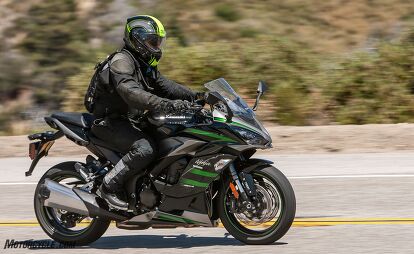
Helmet: Vemar Shark Modular $200
Suit: Aerostich Roadcrafter $1337
Gloves: Dainese Carbon D1 $160
Boots: Sidi Arcadia Tex $179
Hydration: Kriega Rucksack Hydro 3 $155
2020 Kawasaki Ninja 1000 SX Specifications | |
|---|---|
| MSRP | $12,399 |
| Engine Type | 1043cc liquid-cooled inline-Four cylinder, DOHC, four valves per cylinder |
| Bore and Stroke | 77mm x 56mm |
| Compression Ratio | 11.8:1 |
| Horsepower | 124.3 hp at 9500 rpm |
| Torque | 74.6 lb-ft at 7600 rpm |
| Transmission | 6-speed; slip-assist clutch, quickshifter |
| Final Drive | Chain |
| Front Suspension | 41mm inverted fork; adjustable for spring preload, rebound and compression damping, 4.7-inches of travel |
| Rear Suspension | Horizontal single shock; hydraulic spring preload adjuster, rebound damping adjustability, 5.4-inches of travel |
| Front Brake | Dual 300mm discs, radial-mounted four-piston calipers; lean-sensitive ABS |
| Rear Brake | 250mm disc; lean-sensitive ABS |
| Front Tire | 120/70-ZR17 |
| Rear Tire | 190/50-ZR17 |
| Rake/Trail | 24.0 deg/3.9 inches |
| Wheelbase | 56.7 inches |
| Seat Height | 32.1 inches |
| Curb Weight | 517 pounds (MO scales) |
| Fuel Capacity | 5.0 gallons |
| Observed Fuel Mileage | 41 mpg |
| Colors | Black/grey |
| Warranty | 12 months limited warranty; extended coverage available |
More by John Burns



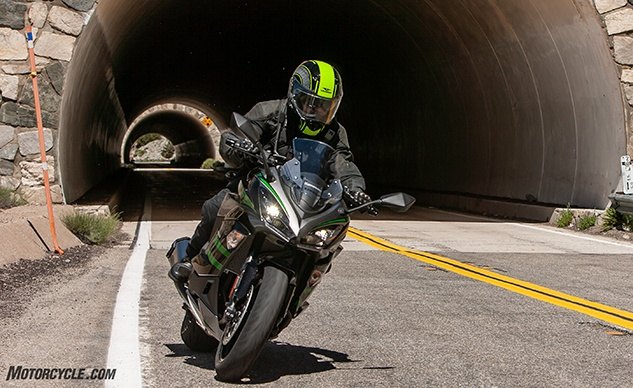












































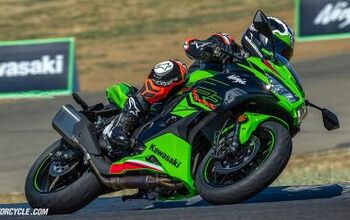
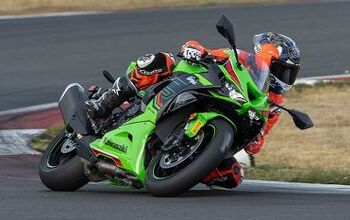

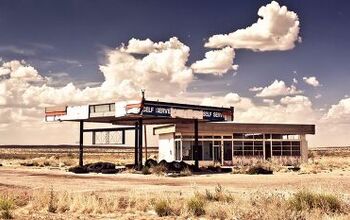










Comments
Join the conversation
But how does it compare to the Concours?
"Where else are you gonna get a highly capable, 124-hp sporty sport-tourer, with cruise control and a quickshifter, for $12,399?"
How about a fresh garage queen K1200S or K1300S for 5-7 K? 170 HP bags and quick shift with heated grips. Only 30 lbs heavier. try it you'll love it!